Critical Appraisal Skills Program (CASP) Analysis: Neonatal Care Study
VerifiedAdded on 2021/06/15
|12
|3192
|50
Homework Assignment
AI Summary
This assignment presents a Critical Appraisal Skills Program (CASP) analysis of a randomized controlled trial that compares the effectiveness of skin-to-skin contact versus conventional incubators for physiological stabilization in newborns. The study, conducted in South Africa, involved infants weighin...

CASP 1
CASP
Student By (Name)
Professor’s (Name)
College
Course
Date
CASP
Student By (Name)
Professor’s (Name)
College
Course
Date
Paraphrase This Document
Need a fresh take? Get an instant paraphrase of this document with our AI Paraphraser
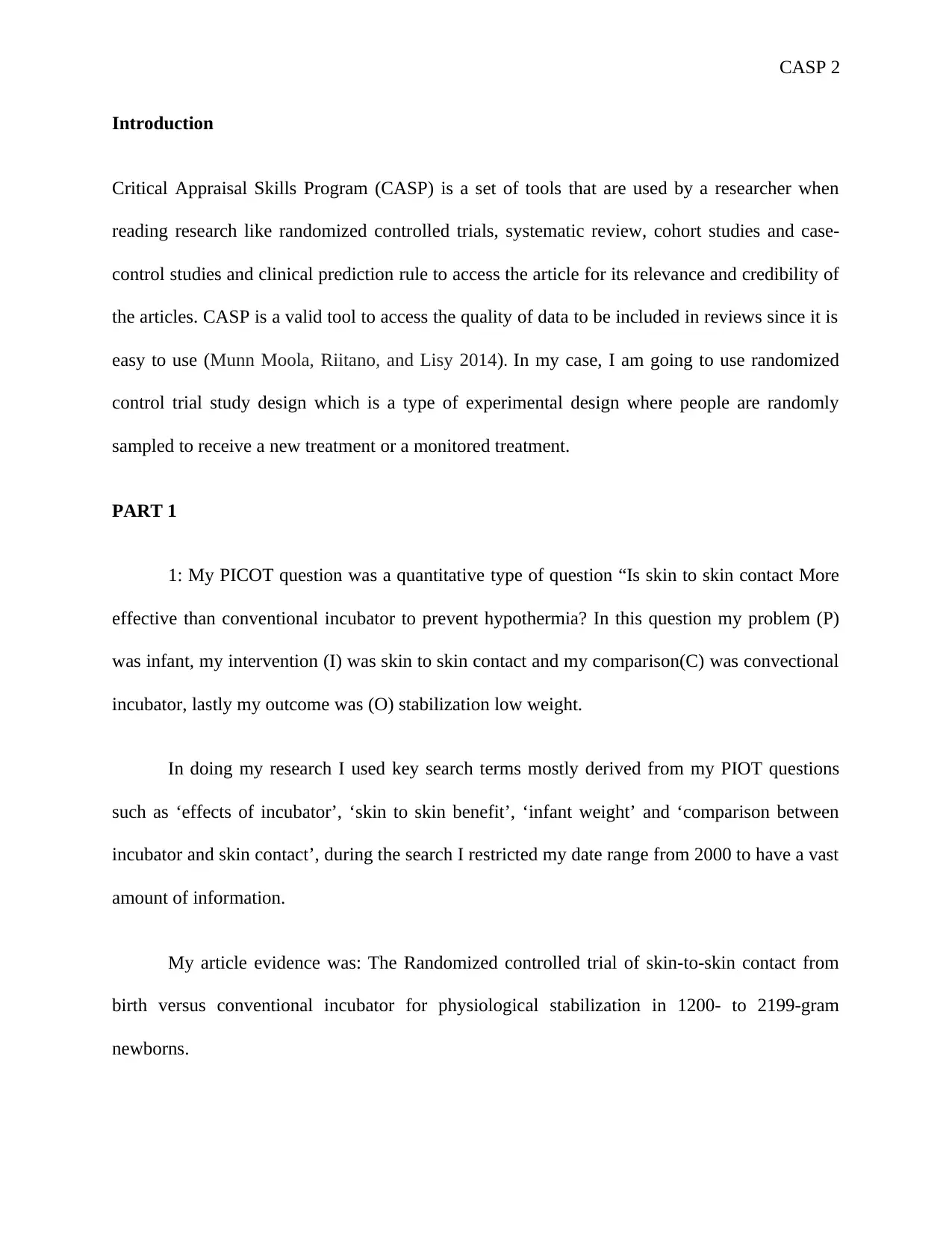
CASP 2
Introduction
Critical Appraisal Skills Program (CASP) is a set of tools that are used by a researcher when
reading research like randomized controlled trials, systematic review, cohort studies and case-
control studies and clinical prediction rule to access the article for its relevance and credibility of
the articles. CASP is a valid tool to access the quality of data to be included in reviews since it is
easy to use (Munn Moola, Riitano, and Lisy 2014). In my case, I am going to use randomized
control trial study design which is a type of experimental design where people are randomly
sampled to receive a new treatment or a monitored treatment.
PART 1
1: My PICOT question was a quantitative type of question “Is skin to skin contact More
effective than conventional incubator to prevent hypothermia? In this question my problem (P)
was infant, my intervention (I) was skin to skin contact and my comparison(C) was convectional
incubator, lastly my outcome was (O) stabilization low weight.
In doing my research I used key search terms mostly derived from my PIOT questions
such as ‘effects of incubator’, ‘skin to skin benefit’, ‘infant weight’ and ‘comparison between
incubator and skin contact’, during the search I restricted my date range from 2000 to have a vast
amount of information.
My article evidence was: The Randomized controlled trial of skin-to-skin contact from
birth versus conventional incubator for physiological stabilization in 1200- to 2199-gram
newborns.
Introduction
Critical Appraisal Skills Program (CASP) is a set of tools that are used by a researcher when
reading research like randomized controlled trials, systematic review, cohort studies and case-
control studies and clinical prediction rule to access the article for its relevance and credibility of
the articles. CASP is a valid tool to access the quality of data to be included in reviews since it is
easy to use (Munn Moola, Riitano, and Lisy 2014). In my case, I am going to use randomized
control trial study design which is a type of experimental design where people are randomly
sampled to receive a new treatment or a monitored treatment.
PART 1
1: My PICOT question was a quantitative type of question “Is skin to skin contact More
effective than conventional incubator to prevent hypothermia? In this question my problem (P)
was infant, my intervention (I) was skin to skin contact and my comparison(C) was convectional
incubator, lastly my outcome was (O) stabilization low weight.
In doing my research I used key search terms mostly derived from my PIOT questions
such as ‘effects of incubator’, ‘skin to skin benefit’, ‘infant weight’ and ‘comparison between
incubator and skin contact’, during the search I restricted my date range from 2000 to have a vast
amount of information.
My article evidence was: The Randomized controlled trial of skin-to-skin contact from
birth versus conventional incubator for physiological stabilization in 1200- to 2199-gram
newborns.

CASP 3
The trial was carried out in two tertiary institutions in South Arica at Cape Town which
treats both public and indigent patients, the mortality rate in this region was 30/1000 and the
survival rate of an inborn was during the study approximately ninety percent, this study led to
identifying women who were likely to give birth to underweight or premature babies who would
wish by their consent for their babies to undergo incubation, mothers were not involved if they
were delivering outside the unit or if they had HIV or if they would give their children up for
adoption (Munn, Moola, Riitano and Lisy, 2014).
This study answered my question which was primarily to determine to compare babies
who underwent incubation versus those who underwent skin to skin contact by their parent; in
that out of the 34 infants who were analyzed those who were above the stability scale were 3/18
compared to 12/13 representing those in the incubator, this means that more of the subjects in the
incubator were below the stability scale This study was carried for unborn babies of weight
between 1200 and 2199 grams who were randomly chosen by the use of a computer used system
in the trial hence population(P) this baby was catered for in terms of their physical and emotional
needs thus intervention(I), they were being compared to those who were not in the incubator
whose mothers were able to raise up naturally hence comparison(C) the outcome was quiet clear
that subjects under the incubator had some problems as compared to those who weren’t which
lead to I evaluating the impact of skin it skin and use of incubators in their respective application
areas hence the outcome(O).There was a six-hour observation period where physiological and
respiratory score were recorded in two hospitals at Cape town South Africa the age bracket was
constant for the subjects.
The trial was carried out in two tertiary institutions in South Arica at Cape Town which
treats both public and indigent patients, the mortality rate in this region was 30/1000 and the
survival rate of an inborn was during the study approximately ninety percent, this study led to
identifying women who were likely to give birth to underweight or premature babies who would
wish by their consent for their babies to undergo incubation, mothers were not involved if they
were delivering outside the unit or if they had HIV or if they would give their children up for
adoption (Munn, Moola, Riitano and Lisy, 2014).
This study answered my question which was primarily to determine to compare babies
who underwent incubation versus those who underwent skin to skin contact by their parent; in
that out of the 34 infants who were analyzed those who were above the stability scale were 3/18
compared to 12/13 representing those in the incubator, this means that more of the subjects in the
incubator were below the stability scale This study was carried for unborn babies of weight
between 1200 and 2199 grams who were randomly chosen by the use of a computer used system
in the trial hence population(P) this baby was catered for in terms of their physical and emotional
needs thus intervention(I), they were being compared to those who were not in the incubator
whose mothers were able to raise up naturally hence comparison(C) the outcome was quiet clear
that subjects under the incubator had some problems as compared to those who weren’t which
lead to I evaluating the impact of skin it skin and use of incubators in their respective application
areas hence the outcome(O).There was a six-hour observation period where physiological and
respiratory score were recorded in two hospitals at Cape town South Africa the age bracket was
constant for the subjects.
⊘ This is a preview!⊘
Do you want full access?
Subscribe today to unlock all pages.

Trusted by 1+ million students worldwide
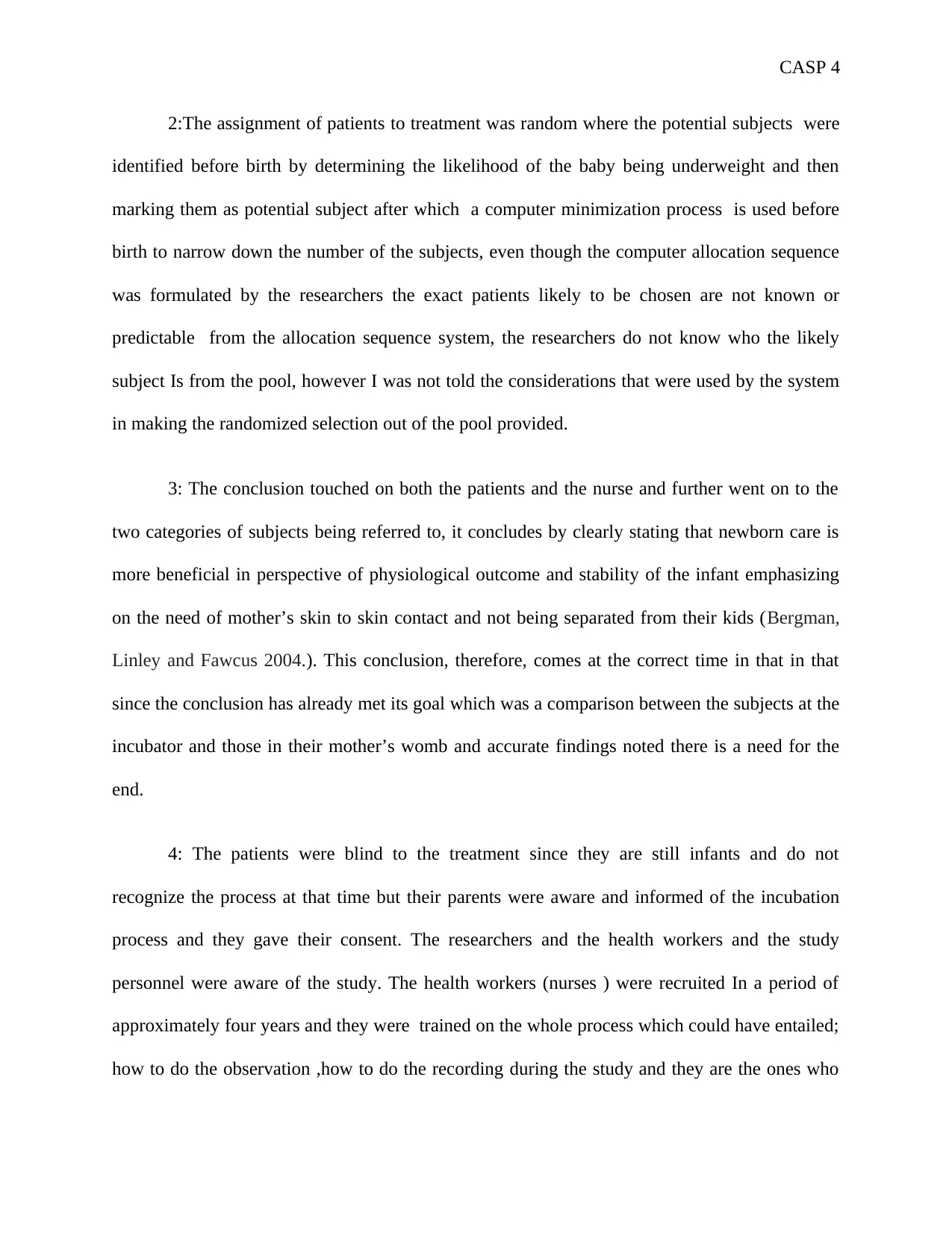
CASP 4
2:The assignment of patients to treatment was random where the potential subjects were
identified before birth by determining the likelihood of the baby being underweight and then
marking them as potential subject after which a computer minimization process is used before
birth to narrow down the number of the subjects, even though the computer allocation sequence
was formulated by the researchers the exact patients likely to be chosen are not known or
predictable from the allocation sequence system, the researchers do not know who the likely
subject Is from the pool, however I was not told the considerations that were used by the system
in making the randomized selection out of the pool provided.
3: The conclusion touched on both the patients and the nurse and further went on to the
two categories of subjects being referred to, it concludes by clearly stating that newborn care is
more beneficial in perspective of physiological outcome and stability of the infant emphasizing
on the need of mother’s skin to skin contact and not being separated from their kids (Bergman,
Linley and Fawcus 2004.). This conclusion, therefore, comes at the correct time in that in that
since the conclusion has already met its goal which was a comparison between the subjects at the
incubator and those in their mother’s womb and accurate findings noted there is a need for the
end.
4: The patients were blind to the treatment since they are still infants and do not
recognize the process at that time but their parents were aware and informed of the incubation
process and they gave their consent. The researchers and the health workers and the study
personnel were aware of the study. The health workers (nurses ) were recruited In a period of
approximately four years and they were trained on the whole process which could have entailed;
how to do the observation ,how to do the recording during the study and they are the ones who
2:The assignment of patients to treatment was random where the potential subjects were
identified before birth by determining the likelihood of the baby being underweight and then
marking them as potential subject after which a computer minimization process is used before
birth to narrow down the number of the subjects, even though the computer allocation sequence
was formulated by the researchers the exact patients likely to be chosen are not known or
predictable from the allocation sequence system, the researchers do not know who the likely
subject Is from the pool, however I was not told the considerations that were used by the system
in making the randomized selection out of the pool provided.
3: The conclusion touched on both the patients and the nurse and further went on to the
two categories of subjects being referred to, it concludes by clearly stating that newborn care is
more beneficial in perspective of physiological outcome and stability of the infant emphasizing
on the need of mother’s skin to skin contact and not being separated from their kids (Bergman,
Linley and Fawcus 2004.). This conclusion, therefore, comes at the correct time in that in that
since the conclusion has already met its goal which was a comparison between the subjects at the
incubator and those in their mother’s womb and accurate findings noted there is a need for the
end.
4: The patients were blind to the treatment since they are still infants and do not
recognize the process at that time but their parents were aware and informed of the incubation
process and they gave their consent. The researchers and the health workers and the study
personnel were aware of the study. The health workers (nurses ) were recruited In a period of
approximately four years and they were trained on the whole process which could have entailed;
how to do the observation ,how to do the recording during the study and they are the ones who
Paraphrase This Document
Need a fresh take? Get an instant paraphrase of this document with our AI Paraphraser
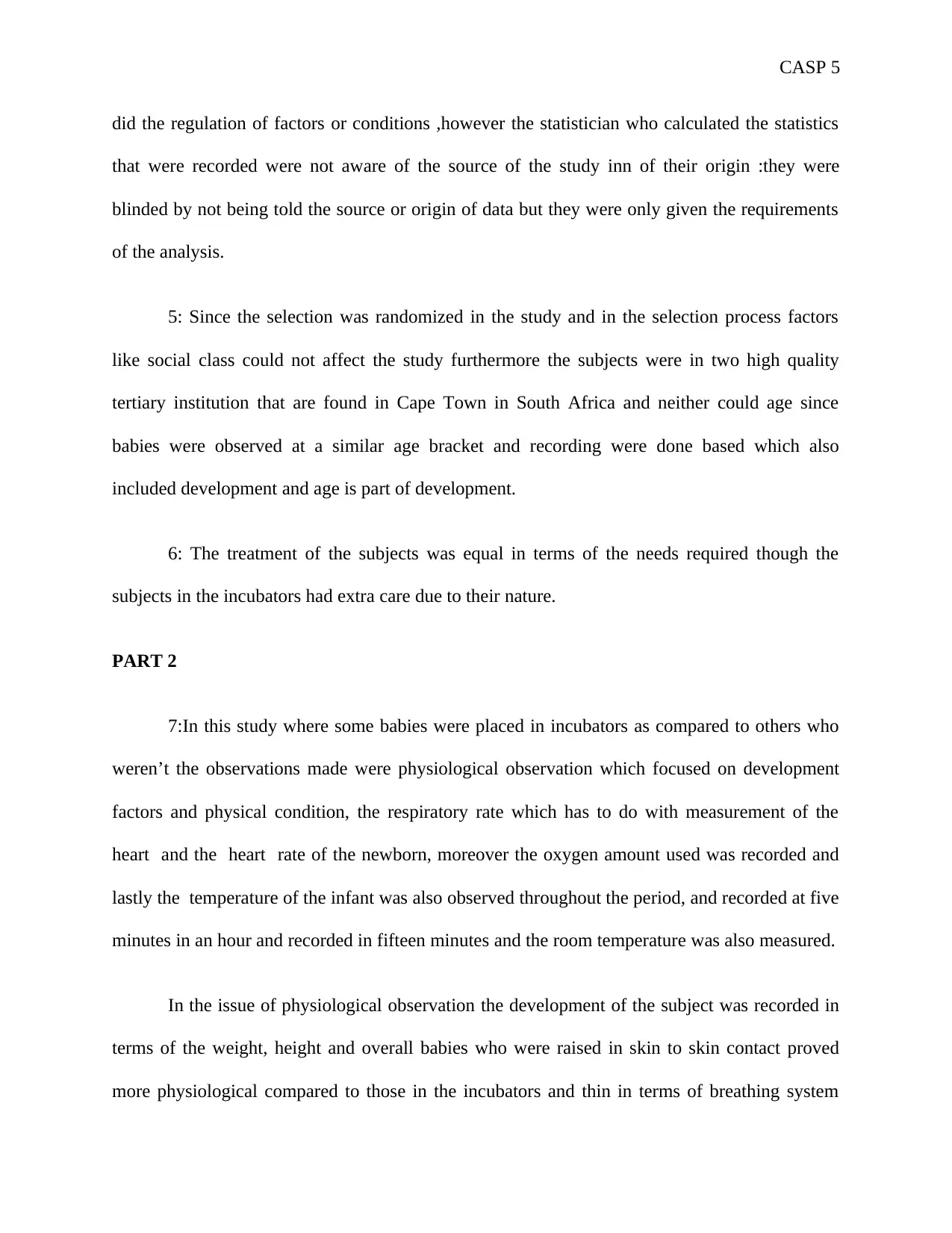
CASP 5
did the regulation of factors or conditions ,however the statistician who calculated the statistics
that were recorded were not aware of the source of the study inn of their origin :they were
blinded by not being told the source or origin of data but they were only given the requirements
of the analysis.
5: Since the selection was randomized in the study and in the selection process factors
like social class could not affect the study furthermore the subjects were in two high quality
tertiary institution that are found in Cape Town in South Africa and neither could age since
babies were observed at a similar age bracket and recording were done based which also
included development and age is part of development.
6: The treatment of the subjects was equal in terms of the needs required though the
subjects in the incubators had extra care due to their nature.
PART 2
7:In this study where some babies were placed in incubators as compared to others who
weren’t the observations made were physiological observation which focused on development
factors and physical condition, the respiratory rate which has to do with measurement of the
heart and the heart rate of the newborn, moreover the oxygen amount used was recorded and
lastly the temperature of the infant was also observed throughout the period, and recorded at five
minutes in an hour and recorded in fifteen minutes and the room temperature was also measured.
In the issue of physiological observation the development of the subject was recorded in
terms of the weight, height and overall babies who were raised in skin to skin contact proved
more physiological compared to those in the incubators and thin in terms of breathing system
did the regulation of factors or conditions ,however the statistician who calculated the statistics
that were recorded were not aware of the source of the study inn of their origin :they were
blinded by not being told the source or origin of data but they were only given the requirements
of the analysis.
5: Since the selection was randomized in the study and in the selection process factors
like social class could not affect the study furthermore the subjects were in two high quality
tertiary institution that are found in Cape Town in South Africa and neither could age since
babies were observed at a similar age bracket and recording were done based which also
included development and age is part of development.
6: The treatment of the subjects was equal in terms of the needs required though the
subjects in the incubators had extra care due to their nature.
PART 2
7:In this study where some babies were placed in incubators as compared to others who
weren’t the observations made were physiological observation which focused on development
factors and physical condition, the respiratory rate which has to do with measurement of the
heart and the heart rate of the newborn, moreover the oxygen amount used was recorded and
lastly the temperature of the infant was also observed throughout the period, and recorded at five
minutes in an hour and recorded in fifteen minutes and the room temperature was also measured.
In the issue of physiological observation the development of the subject was recorded in
terms of the weight, height and overall babies who were raised in skin to skin contact proved
more physiological compared to those in the incubators and thin in terms of breathing system

CASP 6
the respiratory rate both the respiratory of the infants was the same acknowledging that the one
in the incubator can be regulated in term of oxygen saturation both of the subjects had equal
saturation of oxygen where just like in respiration it could be regulated. Overall this study
provided identical care or the same treatment to both subjects except the habitat which for one I
natural and for the other is artificial.
8:The outcomes of this study could be termed good not excellent because the outcome of
this study in form of data measurement was given to the statistician who was blinded and they
performed a statistics on the data given to them without knowledge of its source based on this;
the outcomes were clearly specified unless there were minute errors which were not mentioned
or recognized during the study and also form the experiment, however, maybe if they had known
every detail they would have provided a better way of analyzing data; this is a view and I am not
trying to imply in any way they did a poor job at the statistical analysis it could have been a
better consideration.
In terms of confidence interval there could be very minimal uncertainty concerning the
statistics presented due to the problem with the nurses that resulted to overwork and to some
minor errors with this the confidence interval could be at 95% where the five percent could be of
error that could have resulted during the experiment.
Another problem would have to do with labor as some nurses sought to quit during the
study due to reasons that are not mentioned this could lead to an error whereby to due to
overwork and fatigue the nurse present would have ignored smaller and many but essential
observation but new nurses were recruited, if an area was to occur it would have been during the
the respiratory rate both the respiratory of the infants was the same acknowledging that the one
in the incubator can be regulated in term of oxygen saturation both of the subjects had equal
saturation of oxygen where just like in respiration it could be regulated. Overall this study
provided identical care or the same treatment to both subjects except the habitat which for one I
natural and for the other is artificial.
8:The outcomes of this study could be termed good not excellent because the outcome of
this study in form of data measurement was given to the statistician who was blinded and they
performed a statistics on the data given to them without knowledge of its source based on this;
the outcomes were clearly specified unless there were minute errors which were not mentioned
or recognized during the study and also form the experiment, however, maybe if they had known
every detail they would have provided a better way of analyzing data; this is a view and I am not
trying to imply in any way they did a poor job at the statistical analysis it could have been a
better consideration.
In terms of confidence interval there could be very minimal uncertainty concerning the
statistics presented due to the problem with the nurses that resulted to overwork and to some
minor errors with this the confidence interval could be at 95% where the five percent could be of
error that could have resulted during the experiment.
Another problem would have to do with labor as some nurses sought to quit during the
study due to reasons that are not mentioned this could lead to an error whereby to due to
overwork and fatigue the nurse present would have ignored smaller and many but essential
observation but new nurses were recruited, if an area was to occur it would have been during the
⊘ This is a preview!⊘
Do you want full access?
Subscribe today to unlock all pages.

Trusted by 1+ million students worldwide
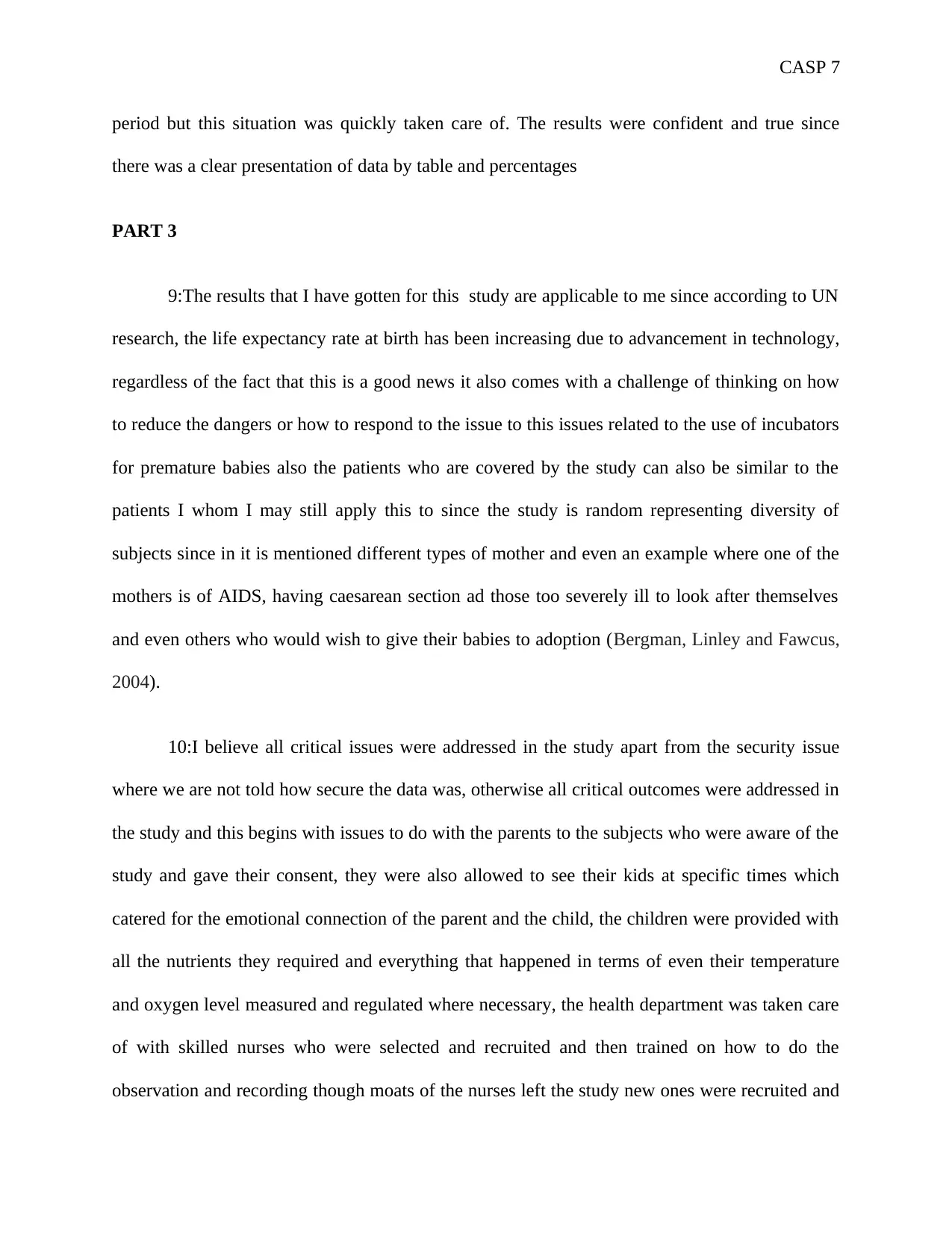
CASP 7
period but this situation was quickly taken care of. The results were confident and true since
there was a clear presentation of data by table and percentages
PART 3
9:The results that I have gotten for this study are applicable to me since according to UN
research, the life expectancy rate at birth has been increasing due to advancement in technology,
regardless of the fact that this is a good news it also comes with a challenge of thinking on how
to reduce the dangers or how to respond to the issue to this issues related to the use of incubators
for premature babies also the patients who are covered by the study can also be similar to the
patients I whom I may still apply this to since the study is random representing diversity of
subjects since in it is mentioned different types of mother and even an example where one of the
mothers is of AIDS, having caesarean section ad those too severely ill to look after themselves
and even others who would wish to give their babies to adoption (Bergman, Linley and Fawcus,
2004).
10:I believe all critical issues were addressed in the study apart from the security issue
where we are not told how secure the data was, otherwise all critical outcomes were addressed in
the study and this begins with issues to do with the parents to the subjects who were aware of the
study and gave their consent, they were also allowed to see their kids at specific times which
catered for the emotional connection of the parent and the child, the children were provided with
all the nutrients they required and everything that happened in terms of even their temperature
and oxygen level measured and regulated where necessary, the health department was taken care
of with skilled nurses who were selected and recruited and then trained on how to do the
observation and recording though moats of the nurses left the study new ones were recruited and
period but this situation was quickly taken care of. The results were confident and true since
there was a clear presentation of data by table and percentages
PART 3
9:The results that I have gotten for this study are applicable to me since according to UN
research, the life expectancy rate at birth has been increasing due to advancement in technology,
regardless of the fact that this is a good news it also comes with a challenge of thinking on how
to reduce the dangers or how to respond to the issue to this issues related to the use of incubators
for premature babies also the patients who are covered by the study can also be similar to the
patients I whom I may still apply this to since the study is random representing diversity of
subjects since in it is mentioned different types of mother and even an example where one of the
mothers is of AIDS, having caesarean section ad those too severely ill to look after themselves
and even others who would wish to give their babies to adoption (Bergman, Linley and Fawcus,
2004).
10:I believe all critical issues were addressed in the study apart from the security issue
where we are not told how secure the data was, otherwise all critical outcomes were addressed in
the study and this begins with issues to do with the parents to the subjects who were aware of the
study and gave their consent, they were also allowed to see their kids at specific times which
catered for the emotional connection of the parent and the child, the children were provided with
all the nutrients they required and everything that happened in terms of even their temperature
and oxygen level measured and regulated where necessary, the health department was taken care
of with skilled nurses who were selected and recruited and then trained on how to do the
observation and recording though moats of the nurses left the study new ones were recruited and
Paraphrase This Document
Need a fresh take? Get an instant paraphrase of this document with our AI Paraphraser
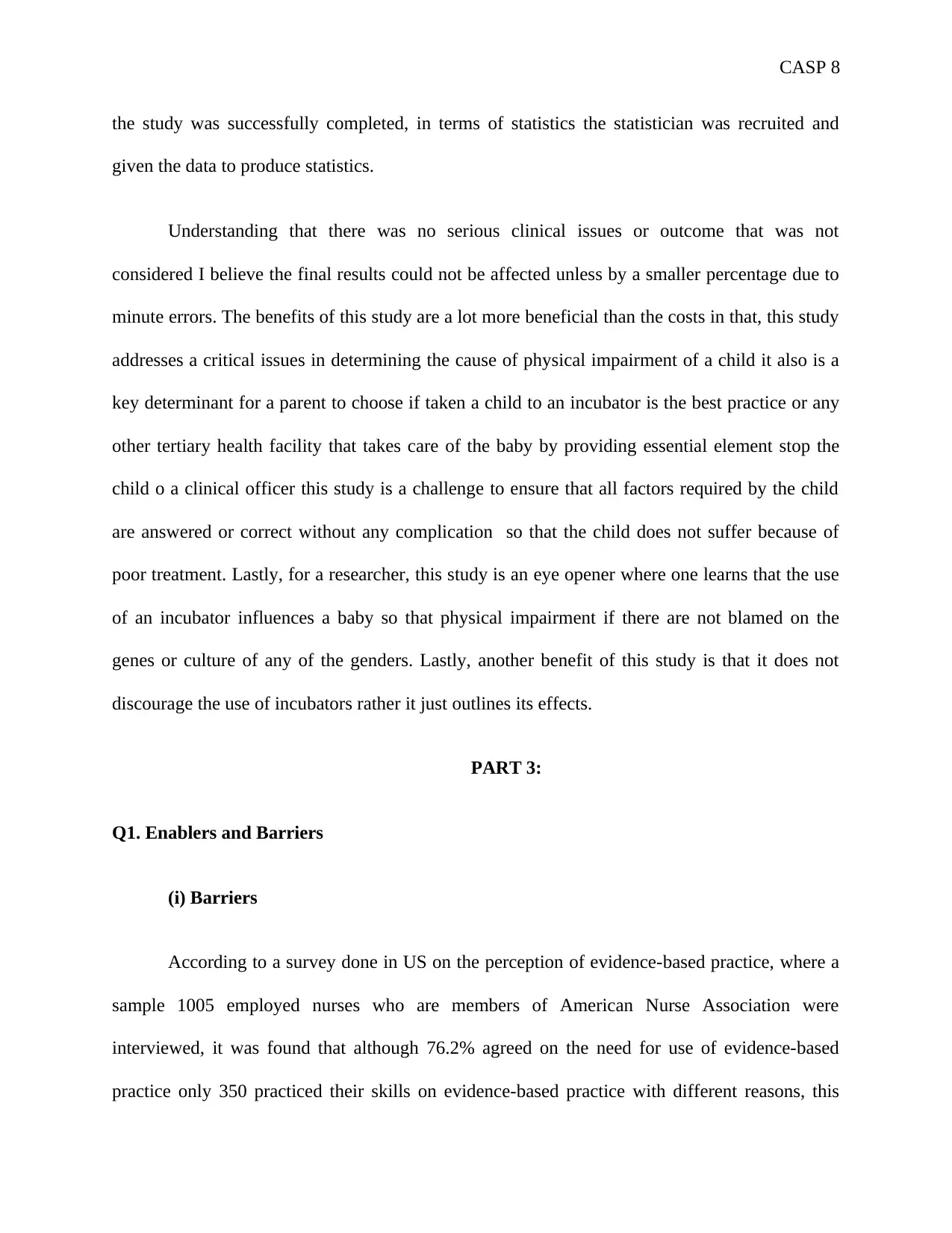
CASP 8
the study was successfully completed, in terms of statistics the statistician was recruited and
given the data to produce statistics.
Understanding that there was no serious clinical issues or outcome that was not
considered I believe the final results could not be affected unless by a smaller percentage due to
minute errors. The benefits of this study are a lot more beneficial than the costs in that, this study
addresses a critical issues in determining the cause of physical impairment of a child it also is a
key determinant for a parent to choose if taken a child to an incubator is the best practice or any
other tertiary health facility that takes care of the baby by providing essential element stop the
child o a clinical officer this study is a challenge to ensure that all factors required by the child
are answered or correct without any complication so that the child does not suffer because of
poor treatment. Lastly, for a researcher, this study is an eye opener where one learns that the use
of an incubator influences a baby so that physical impairment if there are not blamed on the
genes or culture of any of the genders. Lastly, another benefit of this study is that it does not
discourage the use of incubators rather it just outlines its effects.
PART 3:
Q1. Enablers and Barriers
(i) Barriers
According to a survey done in US on the perception of evidence-based practice, where a
sample 1005 employed nurses who are members of American Nurse Association were
interviewed, it was found that although 76.2% agreed on the need for use of evidence-based
practice only 350 practiced their skills on evidence-based practice with different reasons, this
the study was successfully completed, in terms of statistics the statistician was recruited and
given the data to produce statistics.
Understanding that there was no serious clinical issues or outcome that was not
considered I believe the final results could not be affected unless by a smaller percentage due to
minute errors. The benefits of this study are a lot more beneficial than the costs in that, this study
addresses a critical issues in determining the cause of physical impairment of a child it also is a
key determinant for a parent to choose if taken a child to an incubator is the best practice or any
other tertiary health facility that takes care of the baby by providing essential element stop the
child o a clinical officer this study is a challenge to ensure that all factors required by the child
are answered or correct without any complication so that the child does not suffer because of
poor treatment. Lastly, for a researcher, this study is an eye opener where one learns that the use
of an incubator influences a baby so that physical impairment if there are not blamed on the
genes or culture of any of the genders. Lastly, another benefit of this study is that it does not
discourage the use of incubators rather it just outlines its effects.
PART 3:
Q1. Enablers and Barriers
(i) Barriers
According to a survey done in US on the perception of evidence-based practice, where a
sample 1005 employed nurses who are members of American Nurse Association were
interviewed, it was found that although 76.2% agreed on the need for use of evidence-based
practice only 350 practiced their skills on evidence-based practice with different reasons, this
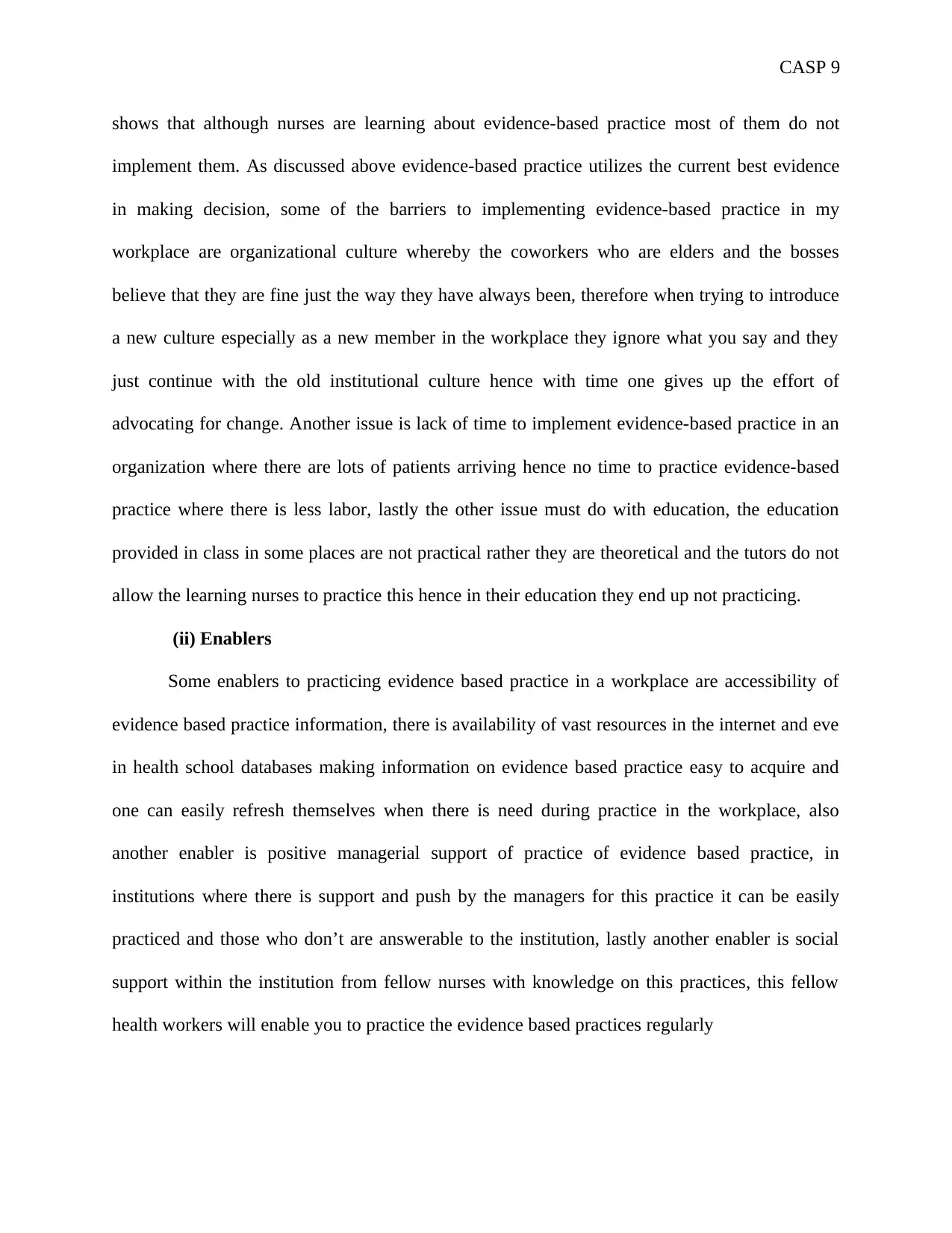
CASP 9
shows that although nurses are learning about evidence-based practice most of them do not
implement them. As discussed above evidence-based practice utilizes the current best evidence
in making decision, some of the barriers to implementing evidence-based practice in my
workplace are organizational culture whereby the coworkers who are elders and the bosses
believe that they are fine just the way they have always been, therefore when trying to introduce
a new culture especially as a new member in the workplace they ignore what you say and they
just continue with the old institutional culture hence with time one gives up the effort of
advocating for change. Another issue is lack of time to implement evidence-based practice in an
organization where there are lots of patients arriving hence no time to practice evidence-based
practice where there is less labor, lastly the other issue must do with education, the education
provided in class in some places are not practical rather they are theoretical and the tutors do not
allow the learning nurses to practice this hence in their education they end up not practicing.
(ii) Enablers
Some enablers to practicing evidence based practice in a workplace are accessibility of
evidence based practice information, there is availability of vast resources in the internet and eve
in health school databases making information on evidence based practice easy to acquire and
one can easily refresh themselves when there is need during practice in the workplace, also
another enabler is positive managerial support of practice of evidence based practice, in
institutions where there is support and push by the managers for this practice it can be easily
practiced and those who don’t are answerable to the institution, lastly another enabler is social
support within the institution from fellow nurses with knowledge on this practices, this fellow
health workers will enable you to practice the evidence based practices regularly
shows that although nurses are learning about evidence-based practice most of them do not
implement them. As discussed above evidence-based practice utilizes the current best evidence
in making decision, some of the barriers to implementing evidence-based practice in my
workplace are organizational culture whereby the coworkers who are elders and the bosses
believe that they are fine just the way they have always been, therefore when trying to introduce
a new culture especially as a new member in the workplace they ignore what you say and they
just continue with the old institutional culture hence with time one gives up the effort of
advocating for change. Another issue is lack of time to implement evidence-based practice in an
organization where there are lots of patients arriving hence no time to practice evidence-based
practice where there is less labor, lastly the other issue must do with education, the education
provided in class in some places are not practical rather they are theoretical and the tutors do not
allow the learning nurses to practice this hence in their education they end up not practicing.
(ii) Enablers
Some enablers to practicing evidence based practice in a workplace are accessibility of
evidence based practice information, there is availability of vast resources in the internet and eve
in health school databases making information on evidence based practice easy to acquire and
one can easily refresh themselves when there is need during practice in the workplace, also
another enabler is positive managerial support of practice of evidence based practice, in
institutions where there is support and push by the managers for this practice it can be easily
practiced and those who don’t are answerable to the institution, lastly another enabler is social
support within the institution from fellow nurses with knowledge on this practices, this fellow
health workers will enable you to practice the evidence based practices regularly
⊘ This is a preview!⊘
Do you want full access?
Subscribe today to unlock all pages.

Trusted by 1+ million students worldwide
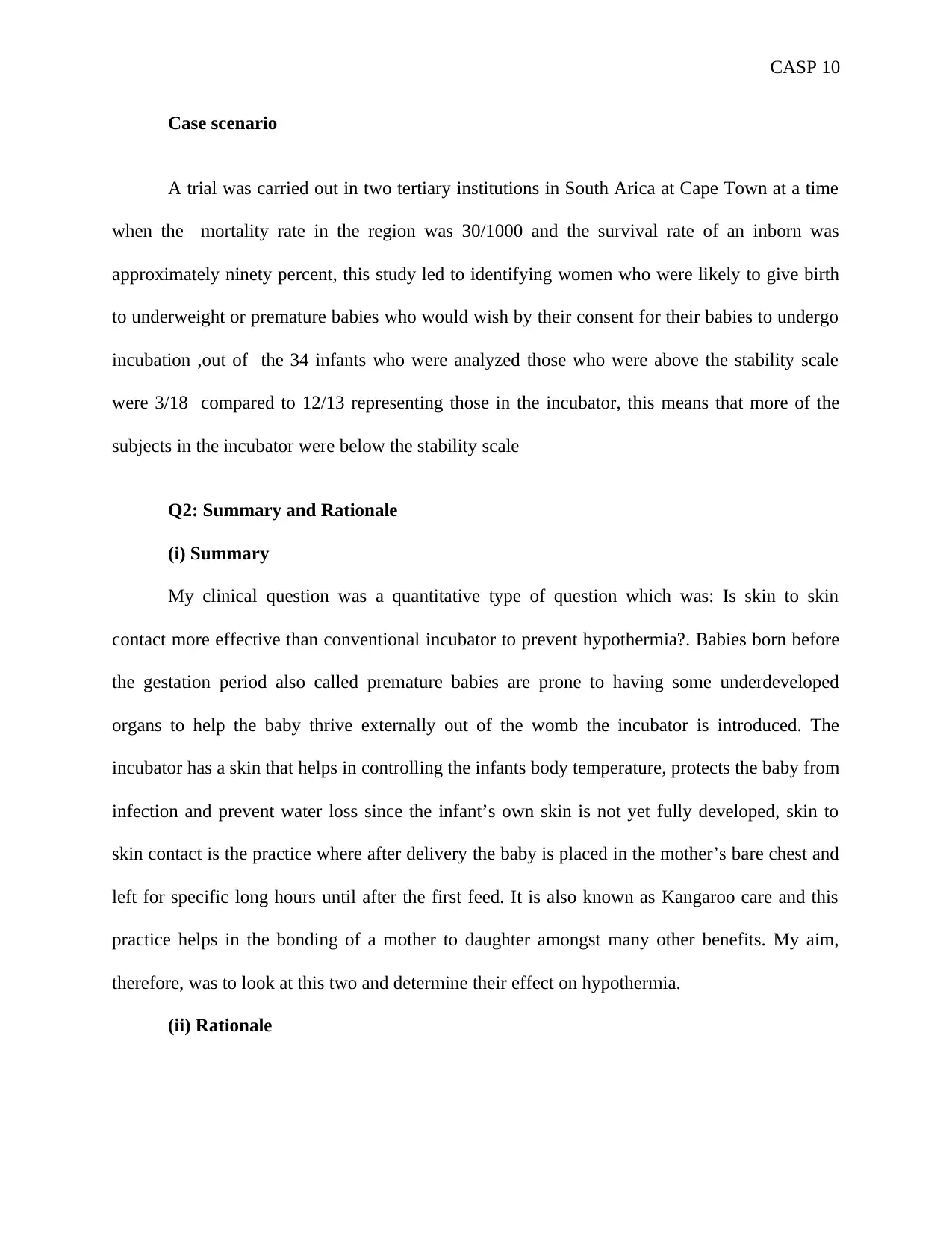
CASP 10
Case scenario
A trial was carried out in two tertiary institutions in South Arica at Cape Town at a time
when the mortality rate in the region was 30/1000 and the survival rate of an inborn was
approximately ninety percent, this study led to identifying women who were likely to give birth
to underweight or premature babies who would wish by their consent for their babies to undergo
incubation ,out of the 34 infants who were analyzed those who were above the stability scale
were 3/18 compared to 12/13 representing those in the incubator, this means that more of the
subjects in the incubator were below the stability scale
Q2: Summary and Rationale
(i) Summary
My clinical question was a quantitative type of question which was: Is skin to skin
contact more effective than conventional incubator to prevent hypothermia?. Babies born before
the gestation period also called premature babies are prone to having some underdeveloped
organs to help the baby thrive externally out of the womb the incubator is introduced. The
incubator has a skin that helps in controlling the infants body temperature, protects the baby from
infection and prevent water loss since the infant’s own skin is not yet fully developed, skin to
skin contact is the practice where after delivery the baby is placed in the mother’s bare chest and
left for specific long hours until after the first feed. It is also known as Kangaroo care and this
practice helps in the bonding of a mother to daughter amongst many other benefits. My aim,
therefore, was to look at this two and determine their effect on hypothermia.
(ii) Rationale
Case scenario
A trial was carried out in two tertiary institutions in South Arica at Cape Town at a time
when the mortality rate in the region was 30/1000 and the survival rate of an inborn was
approximately ninety percent, this study led to identifying women who were likely to give birth
to underweight or premature babies who would wish by their consent for their babies to undergo
incubation ,out of the 34 infants who were analyzed those who were above the stability scale
were 3/18 compared to 12/13 representing those in the incubator, this means that more of the
subjects in the incubator were below the stability scale
Q2: Summary and Rationale
(i) Summary
My clinical question was a quantitative type of question which was: Is skin to skin
contact more effective than conventional incubator to prevent hypothermia?. Babies born before
the gestation period also called premature babies are prone to having some underdeveloped
organs to help the baby thrive externally out of the womb the incubator is introduced. The
incubator has a skin that helps in controlling the infants body temperature, protects the baby from
infection and prevent water loss since the infant’s own skin is not yet fully developed, skin to
skin contact is the practice where after delivery the baby is placed in the mother’s bare chest and
left for specific long hours until after the first feed. It is also known as Kangaroo care and this
practice helps in the bonding of a mother to daughter amongst many other benefits. My aim,
therefore, was to look at this two and determine their effect on hypothermia.
(ii) Rationale
Paraphrase This Document
Need a fresh take? Get an instant paraphrase of this document with our AI Paraphraser
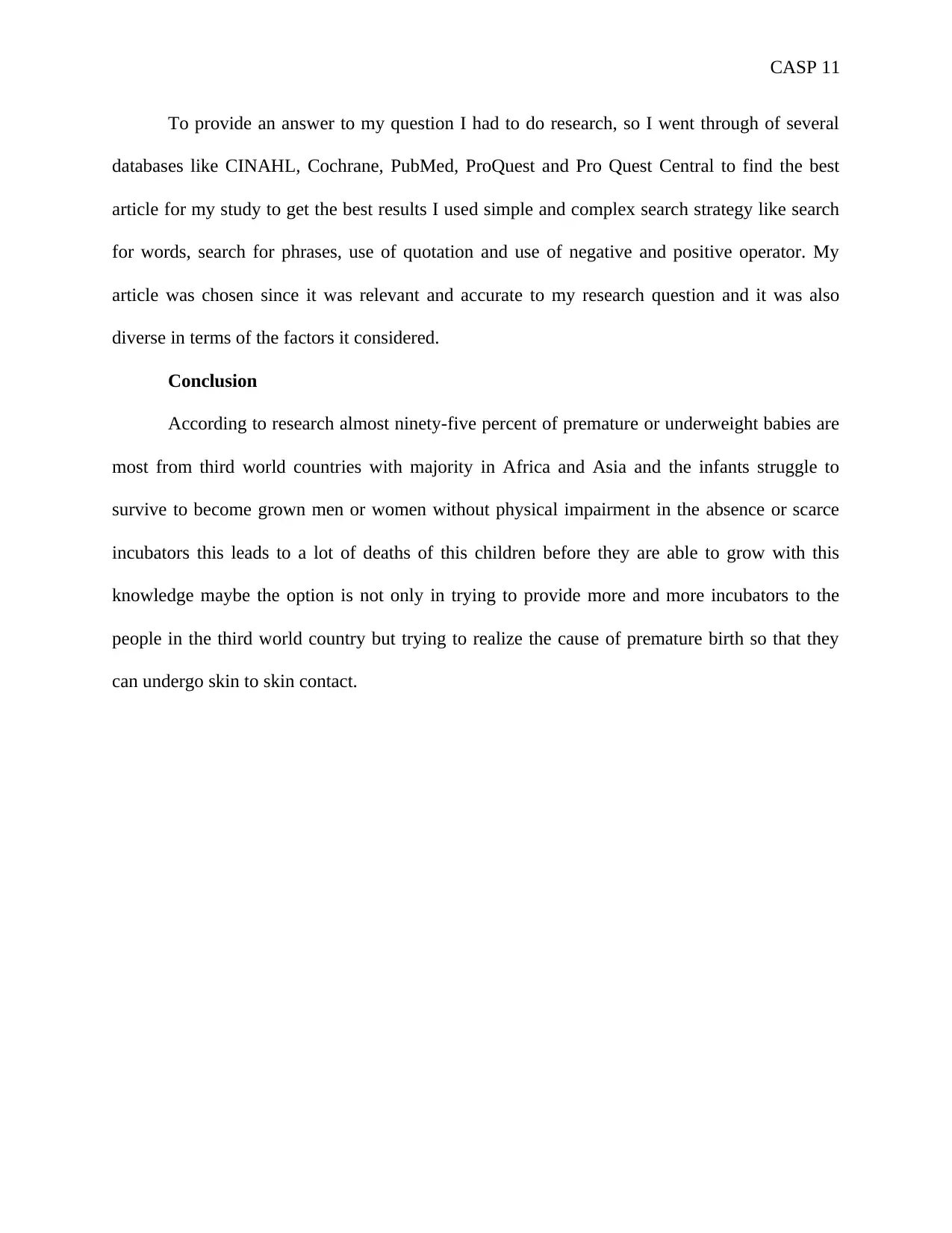
CASP 11
To provide an answer to my question I had to do research, so I went through of several
databases like CINAHL, Cochrane, PubMed, ProQuest and Pro Quest Central to find the best
article for my study to get the best results I used simple and complex search strategy like search
for words, search for phrases, use of quotation and use of negative and positive operator. My
article was chosen since it was relevant and accurate to my research question and it was also
diverse in terms of the factors it considered.
Conclusion
According to research almost ninety-five percent of premature or underweight babies are
most from third world countries with majority in Africa and Asia and the infants struggle to
survive to become grown men or women without physical impairment in the absence or scarce
incubators this leads to a lot of deaths of this children before they are able to grow with this
knowledge maybe the option is not only in trying to provide more and more incubators to the
people in the third world country but trying to realize the cause of premature birth so that they
can undergo skin to skin contact.
To provide an answer to my question I had to do research, so I went through of several
databases like CINAHL, Cochrane, PubMed, ProQuest and Pro Quest Central to find the best
article for my study to get the best results I used simple and complex search strategy like search
for words, search for phrases, use of quotation and use of negative and positive operator. My
article was chosen since it was relevant and accurate to my research question and it was also
diverse in terms of the factors it considered.
Conclusion
According to research almost ninety-five percent of premature or underweight babies are
most from third world countries with majority in Africa and Asia and the infants struggle to
survive to become grown men or women without physical impairment in the absence or scarce
incubators this leads to a lot of deaths of this children before they are able to grow with this
knowledge maybe the option is not only in trying to provide more and more incubators to the
people in the third world country but trying to realize the cause of premature birth so that they
can undergo skin to skin contact.
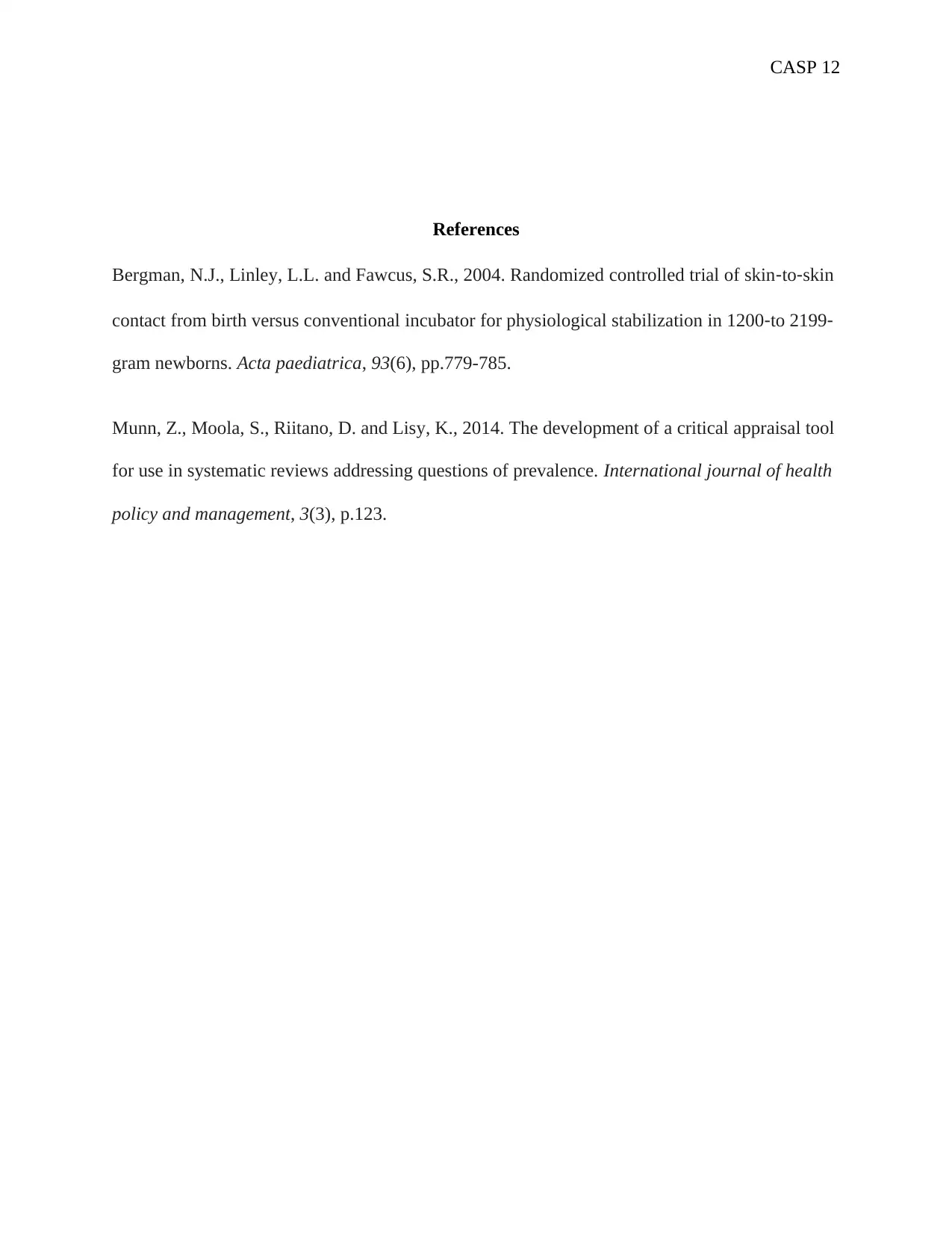
CASP 12
References
Bergman, N.J., Linley, L.L. and Fawcus, S.R., 2004. Randomized controlled trial of skin‐to‐skin
contact from birth versus conventional incubator for physiological stabilization in 1200‐to 2199‐
gram newborns. Acta paediatrica, 93(6), pp.779-785.
Munn, Z., Moola, S., Riitano, D. and Lisy, K., 2014. The development of a critical appraisal tool
for use in systematic reviews addressing questions of prevalence. International journal of health
policy and management, 3(3), p.123.
References
Bergman, N.J., Linley, L.L. and Fawcus, S.R., 2004. Randomized controlled trial of skin‐to‐skin
contact from birth versus conventional incubator for physiological stabilization in 1200‐to 2199‐
gram newborns. Acta paediatrica, 93(6), pp.779-785.
Munn, Z., Moola, S., Riitano, D. and Lisy, K., 2014. The development of a critical appraisal tool
for use in systematic reviews addressing questions of prevalence. International journal of health
policy and management, 3(3), p.123.
⊘ This is a preview!⊘
Do you want full access?
Subscribe today to unlock all pages.

Trusted by 1+ million students worldwide
1 out of 12
Your All-in-One AI-Powered Toolkit for Academic Success.
+13062052269
info@desklib.com
Available 24*7 on WhatsApp / Email
![[object Object]](/_next/static/media/star-bottom.7253800d.svg)
Unlock your academic potential
© 2024 | Zucol Services PVT LTD | All rights reserved.